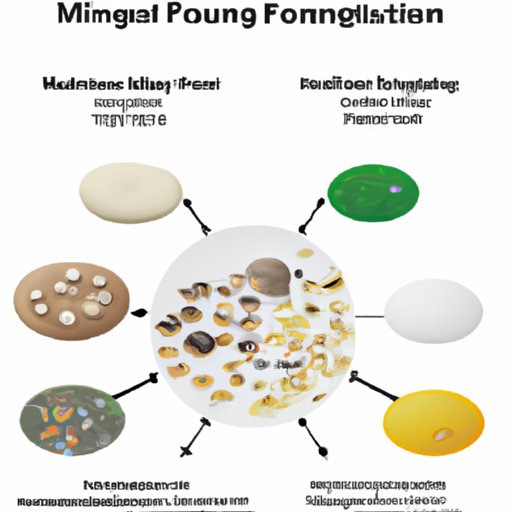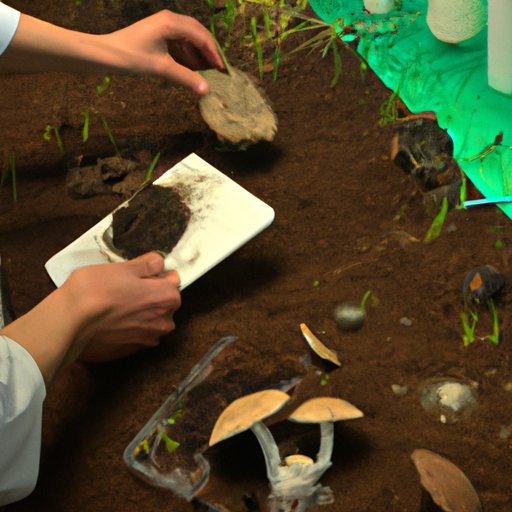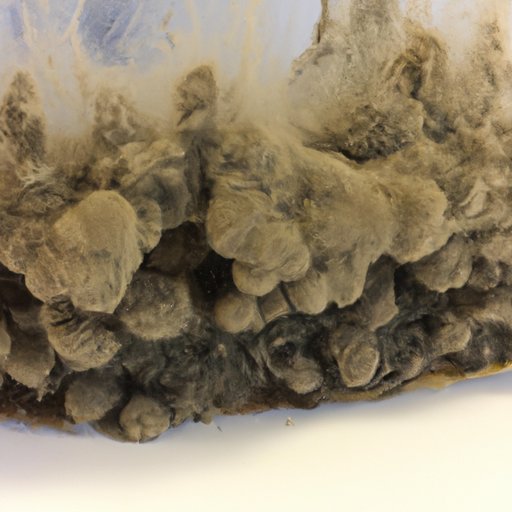Introduction
Fungi are one of the most diverse groups of organisms on the planet. They exist in a wide range of habitats, from the ocean depths to the upper atmosphere and everywhere in between. While they may seem mysterious and alien, they actually have a lot in common with other living things, including humans. Like us, fungi need food to survive, but how do they get it? This article will explore the various ways in which fungi obtain nutrition.

Comparing Fungal Nutrition to Other Organisms
Nutrition is essential for all organisms, no matter their size or complexity. All living things require a certain combination of proteins, carbohydrates, fats, vitamins, and minerals to survive. However, different types of organisms have different nutritional needs. For example, plants use photosynthesis to convert sunlight into energy and obtain their nutrients from the soil.
Animals, on the other hand, rely on eating other organisms to obtain their nutrients. Humans, for instance, consume a variety of foods, from fruits and vegetables to meats and dairy products. Fungi, too, need to eat, but they have unique nutritional needs that set them apart from other organisms.
Exploring Fungi’s Unique Nutritional Needs
Most fungi obtain their nutrition by breaking down organic material into simple molecules that can be absorbed and used as energy. To do this, they produce complex enzymes that aid in digestion and absorption. These enzymes help break down large molecules into smaller ones that can be more easily absorbed.
Fungi also have a unique relationship with their hosts. Many parasitic fungi live on or within other organisms and rely on them for nutrition. The fungus will attach itself to the host and extract nutrients from its body. Some fungi even form a symbiotic relationship with their hosts, exchanging nutrients for protection.
Fungi also rely on their mycelium to obtain nutrition. Mycelium is a network of thread-like filaments that form the main body of the fungus. It helps the fungus absorb nutrients from its environment, such as decaying plant matter or animal waste. The mycelium can also form relationships with other organisms, allowing it to obtain nutrients from them.
Examining the Role of Fungal Spores in Nutrition Acquisition
Fungal spores play an important role in nutrition acquisition. They are small, lightweight structures that allow the fungus to disperse and spread its genetic material. When a spore lands in a suitable environment, it can germinate and begin to grow. As it grows, the fungus will produce enzymes that help it break down organic material and absorb its nutrients.
The availability of nutrients in the environment can also affect the success of fungal spores. If there is not enough food available, the spore may not be able to survive. On the other hand, if the environment is rich in nutrients, the spore may be able to thrive and reproduce.

Investigating the Interaction Between Fungi and Soil Microbes for Nutrition
Fungi often interact with soil microbes to obtain nutrition. Microbes are tiny organisms that live in the soil and decompose organic material, releasing nutrients that can be absorbed by fungi. Fungi can also exchange nutrients with soil microbes, providing them with sugars and other compounds in exchange for nitrogen and other essential nutrients.
In addition, fungi can help increase the amount of nutrients in the soil by breaking down organic material and releasing essential minerals. This process is known as mineralization and is vital for healthy soils and plants.
By understanding the relationship between fungi and soil microbes, farmers and gardeners can maximize the amount of nutrition available to their crops. Adding compost, mulch, and other organic materials to the soil can help improve the nutrient content and provide additional food sources for fungi.
Conclusion
Fungi are fascinating organisms with unique nutritional needs. They obtain their nutrition by breaking down organic material, forming relationships with other organisms, and interacting with soil microbes. By understanding their nutritional needs, farmers and gardeners can take steps to ensure that their crops receive the necessary nutrients.
This article has explored how fungi obtain nutrition and the importance of understanding the relationship between fungi and their environment. With careful management, we can help ensure that fungi continue to thrive in our ecosystems.
(Note: Is this article not meeting your expectations? Do you have knowledge or insights to share? Unlock new opportunities and expand your reach by joining our authors team. Click Registration to join us and share your expertise with our readers.)
